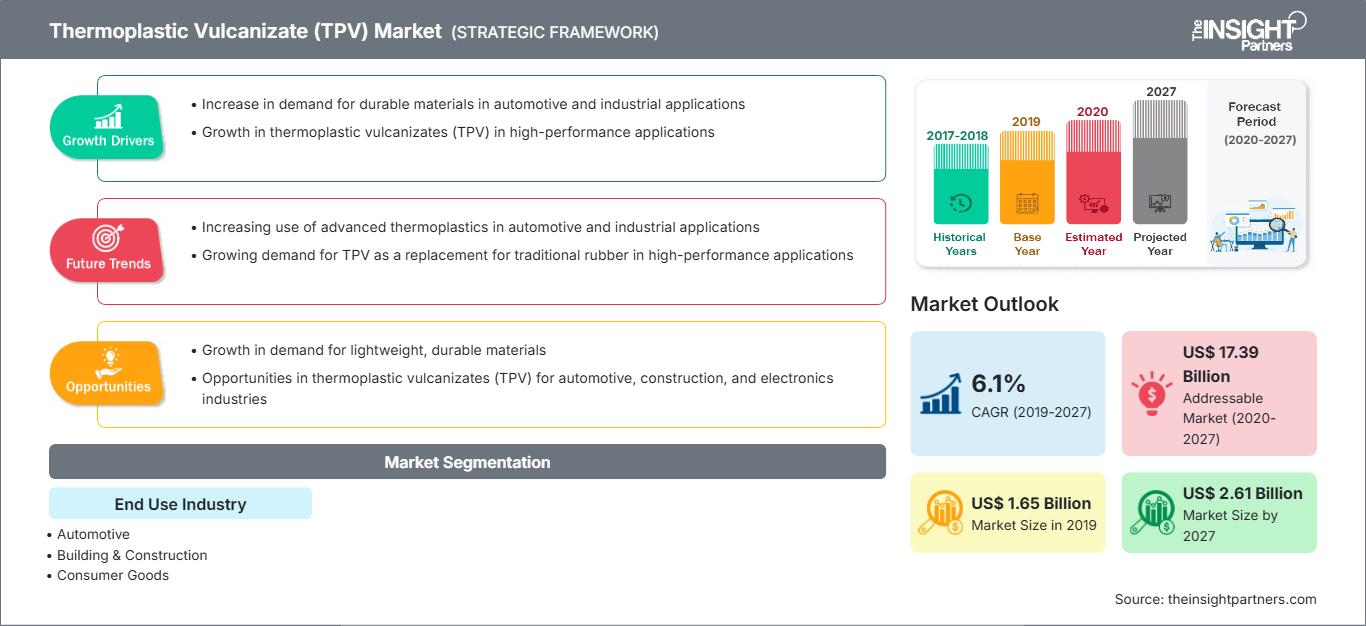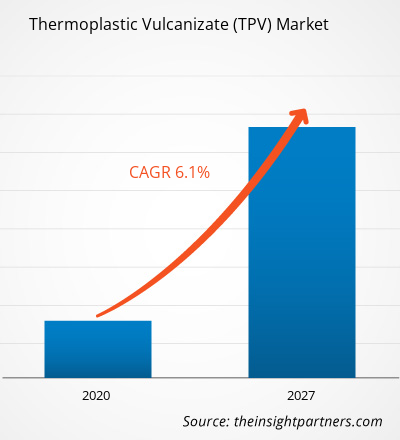El mercado de vulcanizado termoplástico (TPV) se valoró en US$ 1.646,78 millones en 2019 y se proyecta que alcance los US$ 2.612,50 millones para 2027; se espera que crezca a una CAGR del 6,1% durante el período de pronóstico.
Los vulcanizados termoplásticos se utilizan en una amplia variedad de productos, como lavadoras y secadoras, lavavajillas, pequeños electrodomésticos, manijas y sellos, y refrigeradores, para piezas rígidas y sellos. Se espera que la demanda de vulcanizados termoplásticos en el sector de bienes de consumo aumente debido a sus beneficios como materiales ligeros, versátiles y suaves en diferentes áreas de aplicación, incluyendo ropa, electrodomésticos, productos de cuidado personal, utensilios de cocina y herramientas eléctricas. Además, se espera que el crecimiento de la industria de bienes de consumo en los países BRIC también tenga un impacto positivo en el mercado de vulcanizados termoplásticos. Los vulcanizados termoplásticos (TPV) proporcionan una excelente eficiencia, costos de sistema reducidos y sostenibilidad potencial. Debido a estos beneficios, los TPV se utilizan en la industria de bienes de consumo. Por ejemplo, ExxonMobil Chemical produce vulcanizados termoplásticos (TPV) con elastómeros de alto rendimiento que brindan versatilidad en la producción, facilidad de procesamiento y durabilidad. Al brindar un rendimiento superior y consistente en aplicaciones industriales y de consumo exigentes, el TPV ofrece el potencial de menores costos del dispositivo, menor peso y reciclabilidad en comparación con materiales como EPDM (columna vertebral de etileno propileno dieno polimetileno) u otros cauchos termoestables.
Se espera que Norteamérica ocupe la mayor participación en el mercado mundial de vulcanizados termoplásticos (TPV) durante el período de pronóstico. Varias empresas nacionales e internacionales tienen una sólida presencia en la región norteamericana. El crecimiento del mercado de vulcanizados termoplásticos (TPV) en esta región se atribuye principalmente a la creciente demanda de materiales ligeros para la producción de diversos componentes automotrices. Además, se espera que las regulaciones gubernamentales favorables para el consumo de TPV en aplicaciones automotrices como alternativa a las aleaciones y los metales, junto con el aumento de la producción de automóviles de pasajeros en EE. UU. y México, impulsen aún más el crecimiento del mercado regional durante el período de pronóstico. Asimismo, los avances técnicos y la creciente demanda de vehículos eléctricos han incrementado la necesidad de productos ligeros, robustos y reciclables, lo que, a su vez, ha impulsado el crecimiento del mercado.
Estados Unidos, India, Brasil, Rusia, Francia, el Reino Unido, Turquía, Italia y España se encuentran entre los países más afectados en términos de casos confirmados y muertes reportadas debido a COVID-19, a diciembre de 2020. Según los datos de la OMS a diciembre de 2020, se han reportado ~80,453,105 casos confirmados y 1,775,776 muertes en el mundo. La pandemia de COVID-19 ha afectado las economías debido a confinamientos, prohibiciones de viaje y cierres de negocios. La industria mundial de productos químicos y materiales es uno de los principales negocios que sufren interrupciones en la cadena de suministro e interrupciones en la fabricación debido a estas restricciones. China es el centro mundial de fabricación y el mayor proveedor de materias primas para diversas industrias. El confinamiento de varias plantas y fábricas en regiones líderes, como Asia Pacífico y Europa, está afectando las cadenas de suministro globales e impactando negativamente en la fabricación, los cronogramas de entrega y las ventas de productos. Estos factores han afectado negativamente el crecimiento del mercado global de vulcanizado termoplástico (TPV).
Obtendrá personalización en cualquier informe, sin cargo, incluidas partes de este informe o análisis a nivel de país, paquete de datos de Excel, así como también grandes ofertas y descuentos para empresas emergentes y universidades.
Mercado de vulcanizados termoplásticos (TPV): Perspectivas estratégicas

-
Obtenga las principales tendencias clave del mercado de este informe.Esta muestra GRATUITA incluirá análisis de datos, desde tendencias del mercado hasta estimaciones y pronósticos.
Perspectivas del mercado
Uso de vulcanizado termoplástico de origen biológico
Para minimizar la dependencia de recursos no renovables, como el petróleo, y lograr un desarrollo sostenible en la industria de materiales poliméricos, un gran número de personas prefiere materiales poliméricos de origen biológico. Los vulcanizados termoplásticos (TPV) de origen biológico están hechos de poli(lactida) (PLA) y caucho de etileno-co-acetato de vinilo (EVA) que se han fabricado utilizando peróxido de dicumilo (DCP) como agente de curado; es la primera vez que se ha demostrado la aplicación de PLA en materiales elásticos. Dado que los TPV de origen biológico contienen bajas emisiones de carbono y son biodegradables por naturaleza, su síntesis se fomenta en la mayoría de los países. Actualmente se consideran alternativas sostenibles a los polímeros tradicionales derivados del petróleo, ya que se derivan de recursos renovables como polímeros a base de almidón, polilactidas (PLA), polihidroxialcanoatos (PHA), polímeros a base de celulosa y polímeros a base de soja. Como los TPE de origen biológico no solo proporcionan una solución limpia sino que también ofrecen a los productores de TPE de origen biológico competitividad en costos frente a sus contrapartes sintéticas, se espera que creen importantes oportunidades de crecimiento del mercado.
Perspectivas de la industria de uso final
Según la industria de uso final, el mercado de materiales vulcanizados termoplásticos (TPV) se segmenta en automoción, construcción, bienes de consumo, atención médica, entre otros. En 2019, el segmento automotriz dominó el mercado. Los materiales ligeros para automoción han experimentado un fuerte crecimiento en los últimos años debido a la creciente demanda de vehículos de lujo, de bajas emisiones, seguros y de alto rendimiento. Como resultado, proveedores y fabricantes han lanzado diversas soluciones que no solo ayudan a los fabricantes de equipos originales (OEM) a cumplir con las estrictas regulaciones, sino que también satisfacen la creciente gama de demandas de los clientes particulares. Los TPV también son una alternativa razonable a los costosos elastómeros. Ofrecen una excelente durabilidad elastomérica, incluyendo una resistencia a la tracción y un alargamiento a la rotura relativamente altos, una alta recuperación elástica, así como una buena estabilidad dimensional en aire caliente y una excelente resistencia al envejecimiento por rayos UV, al ozono y a la intemperie. Las principales aplicaciones del TVP en la industria automotriz incluyen cubiertas de mangueras, cubiertas de conductos de entrada de aire, juntas, sellos, fuelles corrugados, amortiguadores de vibraciones, cubiertas de puntales, piezas de encendido, bujes y juntas de ventanas. Los componentes flexibles de TPV para automoción bajo el capó incluyen tubos y fuelles de admisión de aire, ensanchamientos de los huecos de las ruedas, fuelles del sistema de dirección y piezas de insonorización. Además, el costo de los TPV se considera entre un 10 % y un 30 % menor que el del EPDM, lo que se combina con un menor peso, una mayor versatilidad de diseño y reciclabilidad.
Mitsui Chemicals Inc., Celanese Corporation, Mitsubishi Chemical Corporation, Kumho Polychem, Trinseo, Teknor Apex, ExxonMobil, Zeon Chemicals LP, Alphagary y Ravago se encuentran entre los actores clave del mercado global de vulcanizados termoplásticos (TPV). Estas empresas están implementando estrategias de desarrollo de nuevos productos, fusiones y adquisiciones para ampliar su cartera de clientes y obtener una cuota de mercado significativa en el mercado global, lo que les permite mantener su marca.
Informe destacado
- Tendencias progresivas de la industria en el mercado global de vulcanizados termoplásticos (TPV) que ayudan a los actores a desarrollar estrategias efectivas a largo plazo.
- Estrategias de crecimiento empresarial adoptadas por los mercados desarrollados y en desarrollo
- Análisis cuantitativo del mercado global de vulcanizados termoplásticos (TPV) de 2017 a 2027
- Estimación de la demanda mundial de vulcanizado termoplástico (TPV) en diversas industrias
- Análisis PEST para ilustrar la eficacia de los compradores y proveedores que operan en la industria
- Desarrollos recientes para comprender el escenario competitivo del mercado y la demanda global de vulcanizados termoplásticos (TPV)
- Tendencias y perspectivas del mercado, y factores que impulsan y restringen el crecimiento del mercado global de vulcanizados termoplásticos (TPV)
- Comprender las estrategias que sustentan el interés comercial con respecto al crecimiento del mercado
- Tamaño del mercado global de vulcanizados termoplásticos (TPV) en varios nodos del mercado
- Descripción detallada y segmentación del mercado, así como de su dinámica industrial.
- Tamaño del mercado global de vulcanizado termoplástico (TPV) en varias regiones con prometedoras oportunidades de crecimiento en las respectivas regiones.
Perspectivas regionales del mercado de vulcanizados termoplásticos (TPV)
Los analistas de The Insight Partners han explicado detalladamente las tendencias regionales y los factores que influyen en el mercado de vulcanizados termoplásticos (TPV) durante el período de pronóstico. Esta sección también analiza los segmentos y la geografía del mercado de vulcanizados termoplásticos (TPV) en América del Norte, Europa, Asia Pacífico, Oriente Medio y África, y América del Sur y Central.
Alcance del informe de mercado de vulcanizados termoplásticos (TPV)
| Atributo del informe | Detalles |
|---|---|
| Tamaño del mercado en 2019 | 1.650 millones de dólares estadounidenses |
| Tamaño del mercado en 2027 | US$ 2.61 mil millones |
| CAGR global (2019-2027) | 6,1% |
| Datos históricos | 2017-2018 |
| Período de pronóstico | 2020-2027 |
| Segmentos cubiertos |
Por industria de uso final
|
| Regiones y países cubiertos |
América del norte
|
| Líderes del mercado y perfiles de empresas clave |
|
Densidad de actores del mercado de vulcanizados termoplásticos (TPV): comprensión de su impacto en la dinámica empresarial
El mercado de vulcanizados termoplásticos (TPV) está creciendo rápidamente, impulsado por la creciente demanda del usuario final debido a factores como la evolución de las preferencias de los consumidores, los avances tecnológicos y un mayor conocimiento de los beneficios del producto. A medida que aumenta la demanda, las empresas amplían su oferta, innovan para satisfacer las necesidades de los consumidores y aprovechan las tendencias emergentes, lo que impulsa aún más el crecimiento del mercado.

- Obtenga una descripción general de los principales actores clave del mercado de vulcanizado termoplástico (TPV)
Mercado de vulcanizados termoplásticos (TPV), por industria de uso final
- Automotor
- Construcción y edificación
- Bienes de consumo
- Cuidado de la salud
- Otros
Perfiles de empresas
- Productos químicos Mitsui Inc.
- Corporación Celanese
- Corporación química Mitsubishi
- Poliquímica Kumho
- Trinseo
- Teknor Apex
- ExxonMobil
- Productos químicos Zeon LP
- Alfagary
- Ravago
- Análisis histórico (2 años), año base, pronóstico (7 años) con CAGR
- Análisis PEST y FODA
- Tamaño del mercado, valor/volumen: global, regional y nacional
- Industria y panorama competitivo
- Conjunto de datos de Excel
Informes recientes
Testimonios
Razón para comprar
- Toma de decisiones informada
- Comprensión de la dinámica del mercado
- Análisis competitivo
- Información sobre clientes
- Pronósticos del mercado
- Mitigación de riesgos
- Planificación estratégica
- Justificación de la inversión
- Identificación de mercados emergentes
- Mejora de las estrategias de marketing
- Impulso de la eficiencia operativa
- Alineación con las tendencias regulatorias






















 Obtenga una muestra gratuita para - Mercado de vulcanizados termoplásticos (TPV)
Obtenga una muestra gratuita para - Mercado de vulcanizados termoplásticos (TPV)